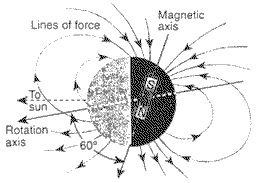 |
Science Frontiers ONLINE No. 97: Jan-Feb 1995 |
|
|
Solar-system puzzles
In the 30-or-so years that space probes have been visiting the solar system's other planets, much has been learned, but there are now more questions than ever. We now pose four of these -- none of them could even have been asked before the space program.
 Not only is the magnetic axis of Uranus tilted grotesquely away from the planet's axis of rotation, but the latter lies almost in Uranus' orbital plane. |
Q2. "Why does Mercury have an iron core twice as massive, relative to its size, as any other rocky planet?" A2. Probably because a giant impact tore off its rocky mantle.
Q3. "How can Neptune sustain 1400-kilometer-per-hour winds -- faster than Jupiter's -- when it is so far from the sun, whose heat powers atmospheric circulation?" A3. ??
Q4. "How could Mars -- now more than 50�C below freezing -- have been warm enough in its early days to have water flowing on its surface?" A4. Possibly due to geothermal heat.
(Kerr, Richard A.; "The Solar System's New Diversity," Science, 265:1360, 1994.)
Reference. A large collection of solar-system anomalies exists in our catalog volume: The Moon and the Planets. To order, visit here.